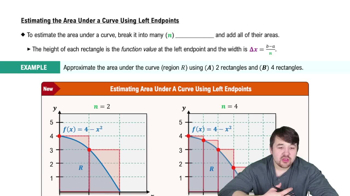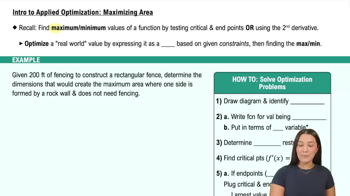{Use of Tech } Minimizing sound intensity Two sound speakers are 100 m apart and one speaker is three times as loud as the other speaker. At what point on a line segment between the speakers is the sound intensity the weakest? (Hint: Sound intensity is directly proportional to the sound level and inversely proportional to the square of the distance from the sound source.)
Table of contents
- 0. Functions7h 54m
- Introduction to Functions16m
- Piecewise Functions10m
- Properties of Functions9m
- Common Functions1h 8m
- Transformations5m
- Combining Functions27m
- Exponent rules32m
- Exponential Functions28m
- Logarithmic Functions24m
- Properties of Logarithms36m
- Exponential & Logarithmic Equations35m
- Introduction to Trigonometric Functions38m
- Graphs of Trigonometric Functions44m
- Trigonometric Identities47m
- Inverse Trigonometric Functions48m
- 1. Limits and Continuity2h 2m
- 2. Intro to Derivatives1h 33m
- 3. Techniques of Differentiation3h 18m
- 4. Applications of Derivatives2h 38m
- 5. Graphical Applications of Derivatives6h 2m
- 6. Derivatives of Inverse, Exponential, & Logarithmic Functions2h 37m
- 7. Antiderivatives & Indefinite Integrals1h 26m
- 8. Definite Integrals4h 44m
- 9. Graphical Applications of Integrals2h 27m
- 10. Physics Applications of Integrals 3h 16m
- 11. Integrals of Inverse, Exponential, & Logarithmic Functions2h 31m
- 12. Techniques of Integration7h 41m
- 13. Intro to Differential Equations2h 55m
- 14. Sequences & Series5h 36m
- 15. Power Series2h 19m
- 16. Parametric Equations & Polar Coordinates7h 58m
5. Graphical Applications of Derivatives
Applied Optimization
Problem 4.R.43
Textbook Question
Maximum area A line segment of length 10 joins the points (0, p) and (q, 0) to form a triangle in the first quadrant. Find the values of p and q that maximize the area of the triangle.
 Verified step by step guidance
Verified step by step guidance1
First, understand that the line segment forms a right triangle with the x-axis and y-axis. The vertices of the triangle are (0, 0), (0, p), and (q, 0). The area of a triangle is given by the formula: \( \text{Area} = \frac{1}{2} \times \text{base} \times \text{height} \). Here, the base is q and the height is p.
Next, use the distance formula to express the relationship between p and q. The length of the line segment is 10, so we have: \( \sqrt{p^2 + q^2} = 10 \). This can be rewritten as \( p^2 + q^2 = 100 \).
Express the area of the triangle in terms of one variable using the constraint \( p^2 + q^2 = 100 \). The area \( A \) can be written as \( A = \frac{1}{2}pq \).
To maximize the area, substitute \( q = \sqrt{100 - p^2} \) into the area formula: \( A = \frac{1}{2}p\sqrt{100 - p^2} \).
Differentiate the area function with respect to p, set the derivative equal to zero, and solve for p to find the critical points. Then, use the second derivative test or analyze the critical points to determine which values of p and q maximize the area.
 Verified video answer for a similar problem:
Verified video answer for a similar problem:This video solution was recommended by our tutors as helpful for the problem above
Video duration:
11mPlay a video:
Was this helpful?
Key Concepts
Here are the essential concepts you must grasp in order to answer the question correctly.
Area of a Triangle
The area of a triangle can be calculated using the formula A = 1/2 * base * height. In this context, the base and height are determined by the coordinates of the points where the line segment intersects the axes. Understanding how to express the area in terms of the variables p and q is essential for maximizing it.
Recommended video:

Estimating the Area Under a Curve Using Left Endpoints
Optimization
Optimization in calculus involves finding the maximum or minimum values of a function. This typically requires taking the derivative of the function, setting it to zero to find critical points, and using the second derivative test to determine whether these points correspond to maxima or minima. In this problem, we will optimize the area function with respect to p and q.
Recommended video:

Intro to Applied Optimization: Maximizing Area
Constraints
Constraints are conditions that must be satisfied in optimization problems. In this case, the length of the line segment is fixed at 10, which creates a relationship between p and q. Recognizing and incorporating this constraint is crucial for correctly formulating the area function and ensuring that the solution adheres to the problem's requirements.
Recommended video:

Intro to Applied Optimization: Maximizing Area

 1:13m
1:13mWatch next
Master Intro to Applied Optimization: Maximizing Area with a bite sized video explanation from Patrick
Start learningRelated Videos
Related Practice
Textbook Question
